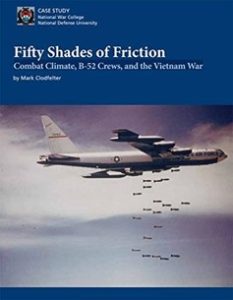- USAF Academy Department of History
Fifty Shades of Friction: Combat Climate, B-52 Crews, and the Vietnam War
by Mark Clodfelter
Entering the Air Force’s Active-duty force in 1955, the eight-engine B-52 “Stratofortress,” dubbed “BUFF” by its crewmembers,8 was an aerial behemoth with a wingspan almost twothirds the length of a football field and designed to deliver nuclear bombs. The bomber displayed America’s aerial might at the height of the Cold War, with crews alternating between flying airborne alert missions with nuclear ordnance and serving “ground alert” with nuclear-laden bombers capable of takeoff 15 minutes after notification. The airborne alert missions, which had begun in 1960, ended in January 1968, but ground alerts endured throughout the Vietnam War. The B-52 force remained a key component of America’s nuclear triad, which also consisted of land-based intercontinental ballistic missiles and nuclear missile–carrying submarines.
A crew of six operated the bomber: a pilot (the aircraft commander) and copilot, both responsible for flying the aircraft and conducting in-flight refueling as needed; a radar-navigator, responsible for bombing and generally the most experienced navigator onboard; a navigator, responsible for guiding the aircraft throughout its mission; an electronic warfare officer, also a navigator and responsible for defending the aircraft from surface-to-air missiles (SAMs) by jamming the signals they received from ground-operated sites; and an enlisted gunner, responsible for defending the aircraft from fighter attack with four .50-caliber radar-guided machine guns located in the tail of the aircraft. In all models of the B-52, the pilot occupied the left seat in the cockpit, while the copilot sat in the right seat, and the electronic warfare officer, dubbed “EWO” or “EW” on most crews, sat facing rearward behind the pilot and copilot. The navigator and radar-navigator sat in a cramped, windowless compartment underneath the cockpit nicknamed the “black hole” and connected to the cockpit above by a ladder. In the F and D model B52s, employed most frequently in the Vietnam War, the gunner sat 150 feet behind the cockpit in the rear of the aircraft underneath its enormous tail in a small, windowed enclosure; in the G model aircraft, which began flying in war in 1972, the gunner sat facing rearward next to the EWO. An intercom system enabled all members of the crew to talk to one another, and when they communicated, they usually identified themselves by their crew position: “pilot,” “copilot,” “radar,” “nav,” “EWO,” and “guns.” The EWO taped those conversations for postmission debriefs. During lulls in the flights—a mission from Guam to South Vietnam and back took over 12 hours—the EWO or another crewman might play music over the system.

